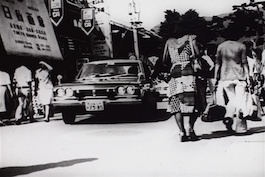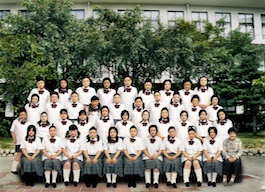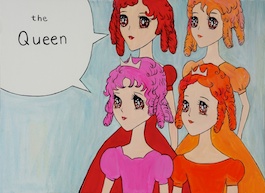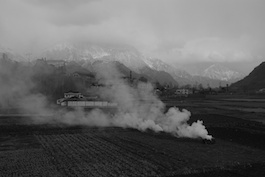The Fall of a Curator: “Nostalgia — East Asia Contemporary Art Exhibition”
“Nostalgia,” a contemporary East Asian art exhibition, opened recently at the Shanghai Museum of Contemporary Art. Presenting works by 14 Chinese, Japanese, and Korean artists, the exhibition puts forward the wish for a certain nostalgia towards the traditional arts — arts that are gradually lost in the process of development as contemporary East Asian art is being influenced by modern Western art.
Born in Korea, lived for years in Japan, and then worked for a Shanghai art institution, the curator of the exhibition, Kim Sunhee, has been active in the promotion of Asian art with over 15 years of experience on the international stage. The identity of someone like Kim Sunhee, with diverse cultural background and experiences, represents exactly the hybrid postmodernity that is borne by a cultural worker in a contemporary globalized society. The title of the exhibition, too, suggests a crisis of identity where self-confidence cannot be ascertained.
On the one hand, she is nostalgic about history and tradition and deplores “the situation in which ways of thinking, traditions and cultures formed over thousands of years are abandoned and replaced by Western civilization.” She hopes to pursue a “path in which East Asian art can occupy an independent place with its own vitality in the international art world.” Yet, on the other hand, the exhibition’s title and selection of artworks again creates the established modes by which the West looks at the East, catering to the powerful Western art authorities. The exhibition takes on “East Asia” in its title along with “nostalgia,” and yet it completely avoids the importance of the politics of history. Thus the exhibition caters to a Western gaze and becomes a pure aesthetic display of exotic Orientalism. This is probably the exhibition’s most serious drawback.
“Nostalgia” refers to an infatuation with the old and the retracing of memories and of a life that has ceased to exist. Such humanistic sentiments oscillate between distinct and indistinct ways of thought: in classical poetry the character “huai” from “huainian” (“nostalgia” in Chinese) can encompass all kinds of emotions and objects between heaven and earth: homesickness (huaixiang), longing for the old (huaigu), longing for mountains (huaishan), and longing for water (huaishui). All that is part of a vanishing history can be brought back to life again in our memories. But there is a price to pay for this revival of history: its first response has a direct connection with pain.
A better counterpart in Chinese to the “nostalgia” in the English title of the exhibition is “huaijiu” (longing for the old). The Latin root nosto represents “going home” while the affixalgos clearly means “pain.” Indeed, the word “nostalgia” first appeared in the medical report of a 17th century medical student from Switzerland. He noticed the intense longing among the Swiss mercenaries for their homeland, and called the “despondency, frustration, and melancholy” thus observed “nostalgia.” From its origins, therefore, nostalgia was treated as a psychological affliction, and the only cure for such an affliction was to return to one’s homeland and to recreate the lost memories. So the title of “nostalgia” manifest this “return,” this desire to recreate memories.
This desire, dispersed throughout the exhibition hall, is almost palpable. The black-and-white images by the Japanese artist Idemitsu Mako make use of the sense of nostalgia inherent within old movies, giving viewers a feeling of temporal and spatial anxiety. The portraits by Sawada Tomoko of young Japanese girls in various attire make one feel the unease in the recreation of identities by contemporary youngsters in their search for a sense of belonging. Meanwhile, the Korean artist Song Hyunsook strove to convey, through traditional Eastern painting techniques, the quintessence of Eastern Zen Buddhism onto images with certain Korean characteristics.
Elsewhere, the Taiwanese artist Tu Weicheng, who has always been obsessed with objects that bears the weight of history and civilization, focuses on old Shanghai-style furniture in his installation. Such Western-style furniture created in Shanghai’s early years also echoes the colonialist history of the city. As part of an exhibition aiming to achieve an independent Asian language, this ambivalent form is overlaid with images that represent everyday life in urban Shanghai. This excessive intuition brings about a strong self-expressiveness and undoubted entertaining value. Adults come to a halt in front of the work while children stop to fiddle with the various handles connected to it. Amid the good old days fondly recreated by objects from the past, the clash of history is drowned in pure fetishism.
Likewise, the video work by Korean artist Won Seoungwon relies too much on modified and recycled computer software. The artist’s own childhood experiences can be seen on the 11 sentimental tableaux, with the landscape and objects all immersed in aesthetic, emotive notions of the East. The repetition and narcissism of these tableaux give off the stale scent of how the East was seen by the West. In a historical retrospective filled with individual feelings, the artist tries to place her own creations against the background of local places being ruthlessly devoured by globalization. Accordingly, all the objects with “Korean” sentiments end up merely making the artworks recollections of recollections.
On a rapidly globalizing world stage, China, Japan and Korea, with their intricate historical, political and economic backgrounds, all emerge with an “East Asian” identity, and this in itself is an expression of conflicts and problems. This notion of “East Asia” renders the voice of this “Other” — which opposes global process of development by representations of nationalism, revisiting history and origins — rather unharmonious. Who is being nostalgic? Nostalgic about what? What kind of history created the situation in which today’s traditional culture is in danger of abandonment and replacement by Western civilization? And who is writing this history?
When highlighting the development of globalization under the new world order, the British cultural scholar Stuart Hall pointed out that the local is opposed to the global and that the development of globalization will not simply be a peaceful evolutionary process at the final stage of history. The development of globalization takes place in a post-modern space filled with conflicts, many of which are not new but are a continuation of a historical process. (1)
In the contemporary art world, the Western-centric viewpoint is a remnant from the colonial era. It regards all cultures outside of its sovereign subject as “Other.” All local cultures are eventually placed under a strong Westernizing mode and become exotic places with local colors. This is exactly Said’s criticism of Orientalism, in which the “East,” under the influence of the “Other,” is under the gaze of the “West” in search of novelties. When the “East Asia Contemporary Art Exhibition” at MoCA conforms exactly to this Western-centric viewpoint, one cannot help thinking it represents the fall of a curator.
Elsewhere, the multichannel video work by the Chinese artist Qiu Anxiong quietly shows us the tranquil life of the Chinese countryside and its yellow earth. Fields of curling smoke and leaves falling down after being shaken up by birds are the ripples that occasionally stir up these nature morte tableaux. Yet we have no way of avoiding the tense and helpless mood revealed in these beautiful landscapes. Glimpses of the city are already gradually permeating the countryside. Perhaps while we are watching, we have already lost our homeland. Here, Qiu Anxiong leaves behind the shell of a dead beetle behind to bring this kind of tasteless emotional deluge to an abrupt halt. Without a doubt, this piece of work is the most critical one in this whole exhibition.
2012.04.30 Mon, by Wang Kaimei Translated by: Inge Wesseling Check out Randian website here





 Back to Index
Back to Index